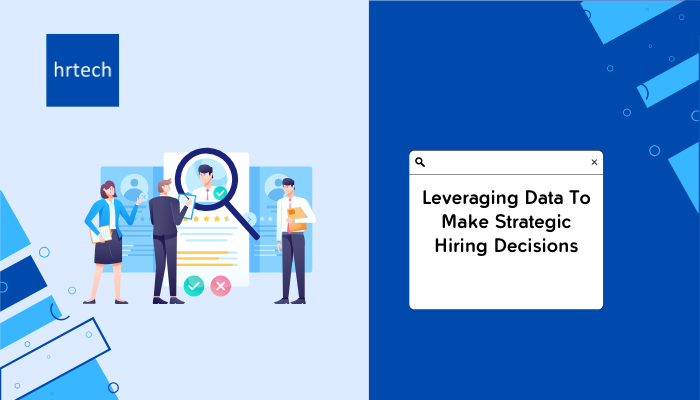The job market is very competitive, and most of the time, there is a lot of attractive top talent chasing a role. Hiring managers often find it challenging to decide on the best talent suited for a role. Talent acquisition analysis makes the process of hiring a lot easier as it involves the use of data in the decision-making process.
This article will discuss the benefits of leveraging data to make strategic hiring decisions and how to use data in the hiring process.

Talent Acquisition Analytics Explained
Talent Acquisition Analytics is a hiring technique that improves how companies hire staff. This technique uses data analysis in the recruitment process, allowing human resources (HR) managers to make decisions based on the data available.
This process involves acquiring and analyzing hiring data, such as the time spent hiring, the cost of hiring, the quality of talent hired, and the effectiveness of available employment channels. Analyzing recruitment data can help identify trends and patterns, which can clarify weaknesses and strengths in the hiring process and the best channels to use when hiring.
For instance, a Singapore forex broker is looking to hire the best candidate for their firm. They would use historical data on the budget, available time, fixed costs, and other factors from previous hires to apply for the upcoming process. After examining where candidates are coming from, they might find that some recruitment channels work better than others. Or, by analyzing how long it takes to fill positions, they can spot delays in their hiring process that need fixing.
Why Should I Implement Talent Acquisition Analysis?
Hire Quality
You will have a better idea of what to expect from the potential talent before they even begin any task. The statistics and data acquired show HR the experience, skills, and compatibility of talents.
Decision Making
With the data collected, you will find it less challenging to pick the most qualified candidate because you will have a clear understanding of what works and what doesn’t. You will be fully aware of the best recruitment channels to use and what part of the recruitment process needs to be optimized.
With this information, recruiters can confidently guide their strategies in the best direction, making the most of their efforts for the best results.
Improved Efficiency
By using real-time contact and company data, recruiters can make their hiring process more efficient. They can quickly find potential hires, communicate with them better, and make decisions based on data. This improves efficiency and saves time and resources used in the recruitment process.
Strategic Competition
Hiring talent is a never-ending battle, often caused by resigning employees and company expansion. Talent acquisition analysis allows recruiters to create engaging employer campaigns targeted at a specific demographic, offering detailed employment experiences that will set their organization apart from others.
How To Leverage Data To Make Strategic Hiring Decisions
Clearly State Your Objectives
Before diving into analytics, it’s crucial to establish clear goals for your talent acquisition strategy. Determine what you aim to achieve, such as reducing time-to-hire, improving candidate quality, or enhancing diversity. Clear objectives guide your data collection and analysis efforts, ensuring that your analytics initiatives are aligned with business needs and can provide actionable insights.
Have Multiple Data Sources
Effective talent acquisition analytics relies on a diverse range of data sources. These can include social media platforms, job boards, employee referrals, and internal databases. By integrating data from multiple sources, you can get an overview of your talent pipeline and identify patterns and trends you cannot get from a single source.
Critically Assess Your Data
Look for reasons why your data might be unreliable and ways you can improve the data collected. This will help you adjust unreliable factors that influence your data and make your data more accurate. You can simplify this process by representing your data using graphs, charts, and other forms of data visualization.
Predictive Analysis
Predictive analytics uses historical data to forecast future hiring outcomes. By analyzing past hiring patterns, you can predict which candidates will most likely succeed in specific roles. Industry leaders utilize professional data analytics services to transform historical recruitment data into accurate hiring predictions and actionable insights. Implementing predictive models can help identify high-potential candidates early in the recruitment process, allowing you to focus your efforts on those most likely to thrive in your organization.
Improve Your Candidate Experience
Analytics can play a pivotal role in enhancing the candidate experience. By tracking candidate interactions and feedback throughout the recruitment process, you can identify points and areas for improvement.
Diversity and Inclusion
Diversity and inclusion are components of a successful talent acquisition strategy. Analytics can help you track diversity metrics throughout the recruitment process, from the initial candidate pool to the final hires. By identifying any disparities or biases, you can proactively create a more inclusive hiring process and ensure a diverse talent pipeline.
Monitor and Improve
Talent acquisition is an ongoing process, and so is the use of analytics. Regularly monitoring key performance indicators (KPIs) such as time-to-hire, cost-per-hire, and candidate satisfaction allows you to measure the effectiveness of your strategies.
Hiring the Right Talent for You
Hiring the right fit for your organization can be a long process, especially when there are many prospective hires. Talent acquisition analysis makes the hiring process much easier by narrowing down trends and patterns with higher success rates. This can save a lot of time and resources while resulting in one of the best possible outcomes.




